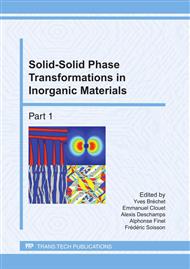p.321
p.331
p.338
p.344
p.350
p.356
p.362
p.372
p.378
Duplex Stainless Steel Microstructural Developments as Model Microstructures for Hot Ductility Investigations
Abstract:
Duplex stainless steels (DSS) are alloys made of ferrite and austenite, with a proportion of each phase around 50%. Their main advantage in comparison with other austenitic and ferritic stainless steels is the attractive combination of high strength and corrosion resistance together with good formability and weldability. Unfortunately, DSS often present a poor hot workability. This phenomenon can stem from different factors associated to the balance of the phases, the nature of the interface, the distribution, size and shape of the second phase, and possibly also from difference in rheology between ferrite and austenite. In order to determine the specific influence of phase morphology on the hot-workability of DSS, two austenite morphologies (E: Equiaxed and W: Widmanstätten) with very similar phase ratio have been generated using appropriate heat treatments. It was checked that the latter treatments generate stable microstructures so that subsequent hot mechanical tests are performed on the microstructures of interest. One microstructure consists of a ferritic matrix with austenitic equiaxed islands while the other microstructure is composed of a ferritic matrix with Widmanstätten austenite. The latter morphology corresponds to the morphology observed in as-cast slabs.
Info:
Periodical:
Pages:
350-355
Citation:
Online since:
June 2011
Price:
Сopyright:
© 2011 Trans Tech Publications Ltd. All Rights Reserved
Share:
Citation:


